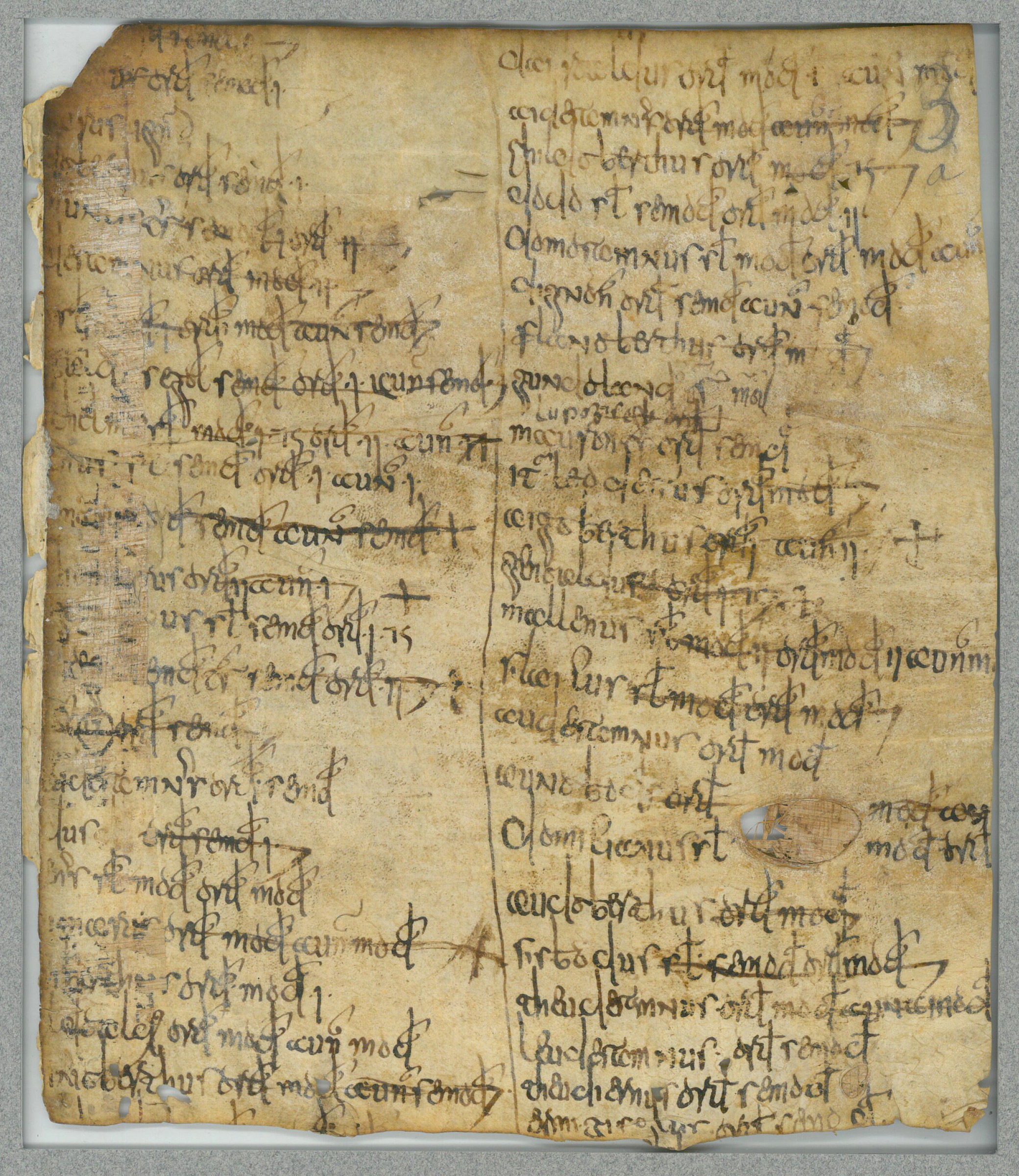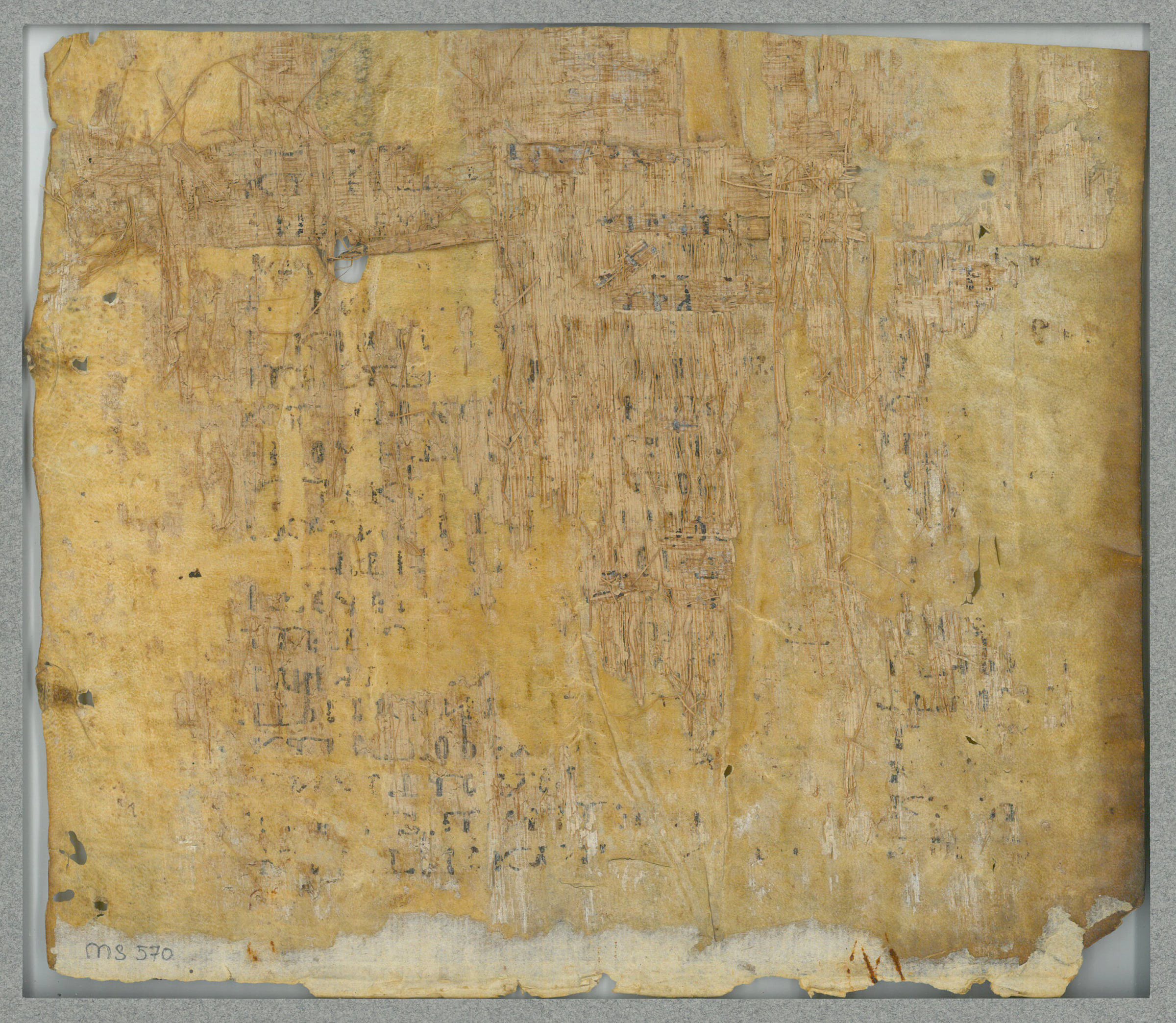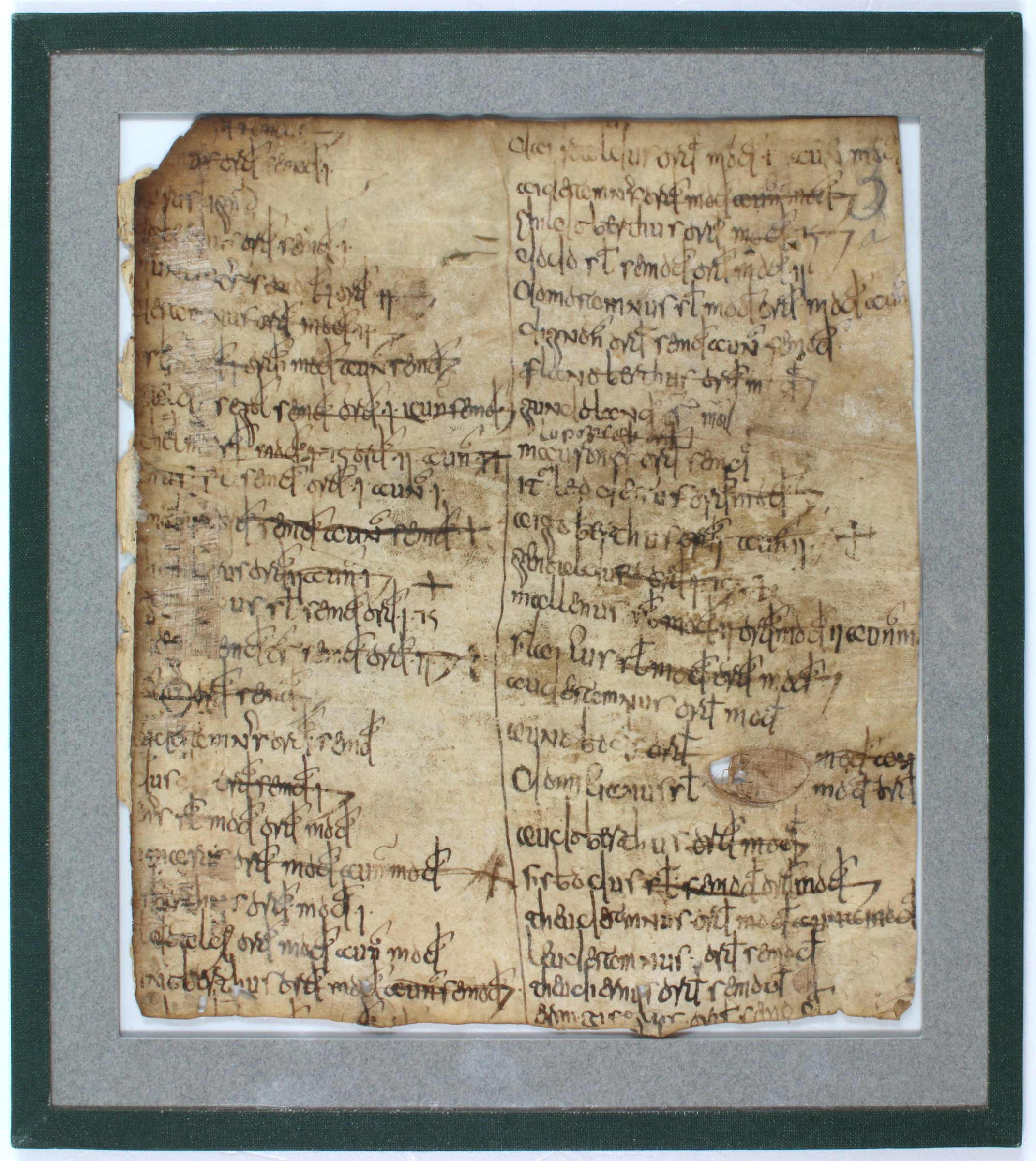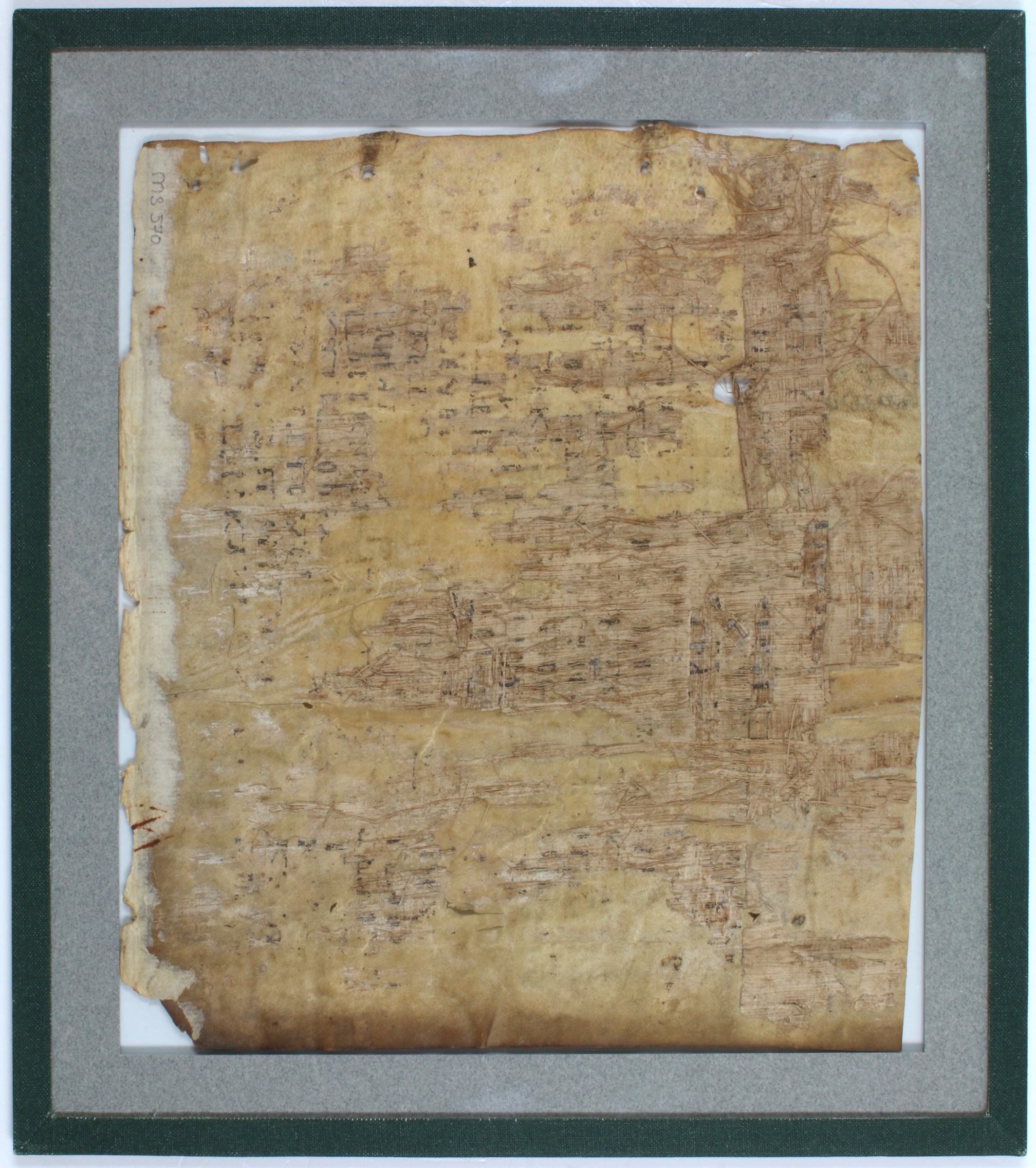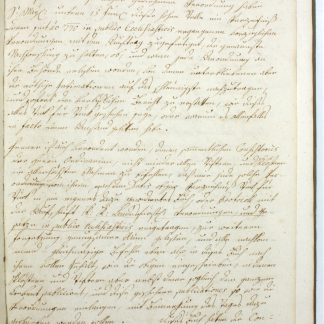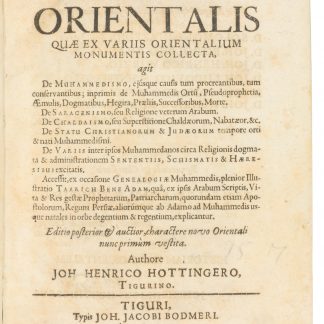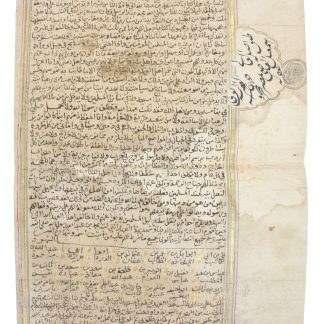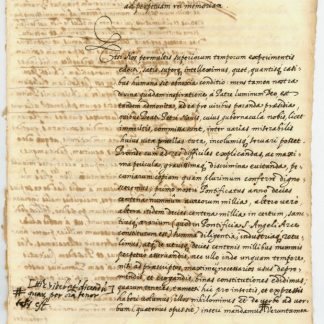From the only extant papyrus codex to have survived from antiquity north of the Alps
The Rental of the Abbey of St Martin's in Tours. (And:) St Ephraim the Syrian, Poem on the Life of St Joseph. Latin manuscript in Merovingian cursive minuscule on vellum, lined with fragments of a papyrus scroll in Greek.
Vellum sheet, 225 x 195 mm. 2 columns on flesh-side of leaf, 22 and 24 entries in brown ink in Merovingian administrative cursive minuscule. Lined on hair-side with sheets of papyrus with remains of 6th or 7th century uncials. Stored between glass within cloth case.
Rare leaf from a major Merovingian manuscript of great historical and palaeographical importance, from the greatest centre of 7th century culture, representing the oldest manuscript of the Tours scriptorium. Its payprus reinforcements preserve part of what is by far the earliest manuscript of St. Ephraim's poem, and indeed the only papyrus witness of a classical text to have survived from antiquity north of the Alps.
The vellum leaf lists the names of 46 tenants of St Martin's Abbey, arranged by coloniae (districts), with the amounts they owed in produce to the community. The text has been published by Gasnault (pp. 310-314). The names, such as Childoberthus, Domoramnus, Dignon, Flanoberthus, Lupogisel, Genoaldus, and Theuderamnus, are among the earliest recorded Gallic names.
The text on the papyrus was identified by the Vatican librarian and scholar Cardinal Giovanni Mercati (1866-1957) from Montfaucon's early 18th century transcriptions, unaware that the original survived, as part of a Greek poem on the life of St Joseph by the Syriac theologian Ephraim the Syrian (ca. 306-373). It is written in a fine uncial of Coptic type of the 6th or 7th century, and by far the earliest and most accurate manuscript of the text. The presence of such a papyrus scroll would appear highly uncommon in early medieval Tours: competent Greek readers in the West were rare even in the 8th or 9th century (Laistner observes that they "can be counted on one hand", Thought & Letters in Western Europe [1931], p. 238), and those of the 7th century were even fewer. However, the scroll may have been more highly prized in the West for its material rather than its text: Gregory of Tours records that there was a substantial trade in the 6th century of papyrus into Europe through Marseilles, and clearly it was the material of choice over vellum, perhaps up until the Carolingian Renaissance. E. A. Lowe surveys the handful of extant papyrus codices and fragments from northern Europe in this period, none of which have ever been offered for public sale, and the present fragments are unique in suggesting the origin of the papyrus in Coptic Egypt.
The vellum manuscript to which this leaf belonged was written at the great 5th-century Abbey of St Martin, Tours, as several fragments now in Paris mention Abbot Agrycus of St Martin's. This is one of the earliest securely localisable manuscripts of Western Europe. The sheets were re-used as part of the binding of an 8th century copy of Philippus on Job in the library of St Martin's (MS 56 in the 18th-century catalogue of Tours Cathedral: see L. Delisle, "Notice sur les manuscrits disparus de la bibliothèque de Tours", Notices et extraits des manuscrits de la Bibl. Nationale 31 [1884], p. 215). They were seen in situ in the early 18th century by the great proto-palaeographer Bernard de Montfaucon (1665-1741), who published a description of them, with an engraving of the papyrus script in his Palaeographica Graeca (1708), pp. 214f., quoting a letter by Dom Léon Chevalier, ca. 1706, on these "Nobilia fragmenta inter membranas varias conglutinae". These were the only papyrus manuscripts Montfaucon had ever seen.
At the Revolution, the manuscripts from the cathedral were transferred to the Bibliothèque Municipale de Tours, and this volume was discarded ca. 1832. The binding was dismembered, and the main body of the volume was sold at auction in Paris in February 1832 (now in the Meerman-Westreenen Museum, The Hague, MS 10.A.1: Lowe, Codices Latini Antiquiores, X, no. 1571). Sir Thomas Phillipps (1792-1872) collected together 31 pieces from this binding: they were sold at Sotheby's in 1967 to H. P. Kraus, who presented them to the Bibliothèque Nationale, where they are now MS nouv.acq.lat.2654. The present leaf, with another, emerged in northern Germany in 1988. Pierre Gasnault concluded that these leaves were given by the 19th-century bookseller who sold the remainder to Phillipps, to Amans-Alexis Monteil (1769-1850) for services involved in the preparation of the catalogue: the note which accompanies this leaf, like that which accompanied the others in 1967, is in Monteil's hand ('Deux nouveaux feuillets', pp. 308f.). In 1833, Monteil sold his collection of paleographical specimens, and the present leaf was doubtless among them. Overall this portion of the text is in finer condition than that acquired by Phillipps, with the present leaf exhibiting the boldest hand of the whole cache. Having entered the Schøyen Collection, it was exhibited by the Comité International de Palaéographie Latin (CIPL) at Senate House, University of London, on 3 September 2008. When it was de-accessioned by Martin Schøyen in 2012, it commanded £157,250 at Sotheby's.
1. Benedictine Abbey of St. Martin, Tours (ca. 675-1789); 2. Bibliothèque Municipale de Tours (1789-1832); 3. Amans-Alexis Monteil (1769-1850), historian, France (1832-33); 4. Monteil sale, Silvestre, Paris 1833, lot 473; 5. Sotheby's, 20 June 1989, lot 26; 6. David Thomson, Toronto; 7. Sam Fogg Rare Books, London; 8. Schoyen Collection, MS 570; 9. Sotheby's, 10 July 2012, lot 15; 10. French private collection.
A single vellum sheet, 225 x 195 mm, with two columns on flesh-side of leaf with 22 and 24 entries in brown ink in an elegant rounded Merovingian administrative cursive minuscule with distinctively open "d", "o"s sharpened to a point at their apex and "g"s with tails that fold back on themselves to form a double line closed at their bottom. Columns separated by a single line of ink. Lined on the hair-side with inward facing sheets of papyrus with remains of uncials of the 6th or 7th century (probably to stabilise the vellum and reduce its curling, as the leaves of this manuscript were clearly kept loose in polyptych form, rather than as a codex or roll: cf. Sati, "Merovingian Accounting Documents", pp. 147-151); single strip of same papyrus adhered to outer edge of flesh-side (perhaps as offset from previous leaf in sequence). Now stored between glass, in a fitted cloth case.
A natural flaw in the vellum and two small cuts with no damage to text, slightly trimmed with losses from inner and lower edges. Traces of paper down one edge of verso from re-use in later binding, otherwise in outstanding condition, with an early 19th-century description (this edited and discussed by Gasnault, "Deux nouveaux feuillets", p. 308). Both the leaf and the early description with the number "3" in early 19th-century hand in their uppermost corners.
Pierre Gasnault, "Deux nouveaux feuillets de la comptabilité domaniale de l'Abbaye Saint-Martin de Tour à l'époque mérovingienne", in: Journal des Savants (June-Dec. 1995), pp. 307-321. Chartae Latinae antiquiores 47 (1997), no. 1404. S. Sati, "The Merovingian Accounting Documents of Tours: form and function", Early Medieval Europe, 9 (2000), pp. 143-161. Cf. ChLA 4 (1967), 238 and XVIII (1985), 659.

